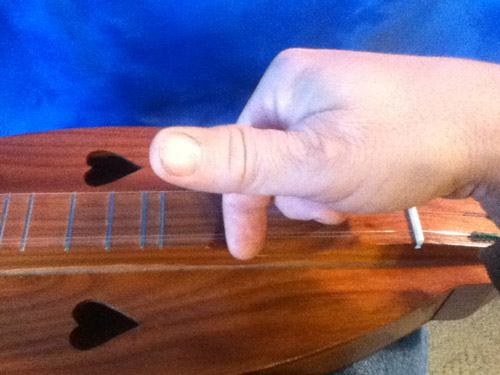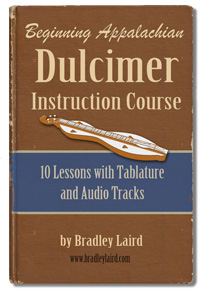| FREE
DULCIMER LESSONS - by Bradley Laird

THE STRINGS OF THE DULCIMER
The most traditional way of playing the dulcimer is to play a melody on the string (or pair of strings) closest to the body. This string (or pair of strings) is called the melody string. Frets are placed along the length of the fret board as “string shortening devices” and, when the string is pressed down against the fret, cause higher pitched notes to be produced.
A physical law of musical strings is that a shorter string produces a higher note assuming the tension and mass of the string remains the same. The tuning machines can alter the tension. A tighter string will be higher in pitch than one which is looser. The mass (usually seen as a thicker string) also affects pitch. More mass (thicker) slows the vibration of the string and produces a lower note.
It is impractical to adjust the tuning “on the fly” while playing, and it is certainly difficult to alter the mass of a string, so pre-positioned frets which shorten the vibrating portion of a string are the best way to produce additional notes.
Since the earliest styles of dulcimer playing involve only fretting the melody string it would not actually be necessary for the frets to extend all the way across the fret board. In fact, some old dulcimers only have little small frets (sometimes metal staples) under the melody string only.

The strings of the dulcimer. Sometimes three, sometimes four.
THE DRONE STRINGS
This brings us to consider the other strings. The thickest string farthest from the players body is called the “bass string.” In traditional playing this string is tuned to one particular note and is not altered during playing. This continuous, unchanging pitch is called a drone string.
The middle string (appropriately called the “middle string”) is also tuned to one particular note and, like the bass string, is not altered during playing. Therefore, the middle string also functions as a drone.
The concept of drones may seem “foreign” to our modern ears but is one of the most ancient of musical concepts. Some other instruments which utilize the drone concept are the bagpipes, the banjo and even some primitive group singing styles. The drone pipes, string or chanters establish a tonal basis over which the melody changes.
It is the interaction of the moving melody against the stable droning backdrop which produces the emotive sensations in the listeners mind. Each new melody note interacts differently in relation to the drone. Some notes seem to harmonize beautifully and others produce varying amounts of discord or tension. This rise and fall of tension is what typifies “melody over drone” music and this is what a dulcimer is designed to do.
Of course, modern music has evolved and there is a desire among some players to, at times, discard the drone concept and play moving notes on the former drone strings. For this reason, these days, the frets extend across the fret board allowing the “drone” strings to change to other notes.
These free introductory online lessons will focus on the more primitive “melody over drone” method. However, in my downloadable PDF eBook I also teach how the middle and bass string can be fretted to produce moving notes.
Take me to free lesson 4...
After you try these free lessons you might also enjoy my complete downloadable PDF eBook which teaches 10 songs in 3 different tunings using strums and a little finger picking too. It comes with 17 MP3 tracks too! Fun stuff! You can read about it here.

Back to Index of Free Dulcimer Lessons
| 


